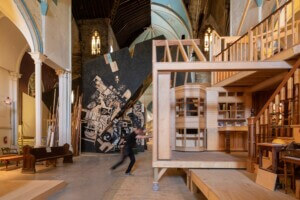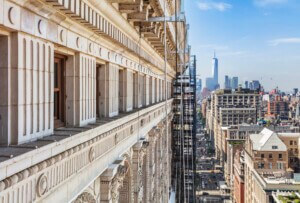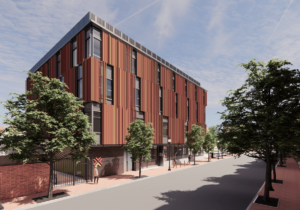Terra-cotta, perhaps best known for its association with pottery and sculpture, is an ancient construction material found in early architecture across Asia, North Africa, and Europe as both a decorative and structural element.
In the United States, architectural terra-cotta experienced a period of immense popularity during the late-19th and early-20th century as a cladding material and structural support for the first generation of skyscrapers. Later on, its popularity diminished in favor of cheaper industrial materials such as glass, concrete, and steel.
However the past decade has witnessed a new revival of architectural terra-cotta. In addition to renewed interest in its artistic properties, architects are increasingly attracted to the material’s low embodied carbon, fueled by concern over worsening climate change.
To encourage this interest Boston Valley Terra Cotta (BVTC), one of the few architectural terra-cotta manufacturers left in the United States, hosts the Architectural Ceramic Assemblies Workshop (ACAW), an annual, week-long event. In partnership with the University of Buffalo (UB) and Carnegie Mellon University (CMU), the manufacturer invites professional and academic teams to Buffalo to create architectural prototypes using the material.
The hands-on conference was first conceived in 2015 by John Krouse, former CEO of BVTC; and Omar Khan, former chair of University of Buffalo’s School of Architecture and Planning. Both have now moved on to new positions—Krouse as chairman of BVTC’s board and Khan as head of CMU’s School of Architecture—but maintain strong involvement in the conference.
Each year, many of the assembly projects seem to coalesce around a shared theme. For example, several of the teams at last year’s event developed green-wall prototypes. Khan and Krouse insist that this occurs organically and that there is never a pre-selected theme or any sort of curation during the application process.
“[The themes] just happen,” said Khan. “It’s really a gestalt that emerges every year. We make sure that the teams aren’t talking to each other.”
At this year’s event, many of the professional prototypes and academic research experimented with terra-cotta’s interactions with water. This took the form of modules and research projects addressing water retention, evaporative cooling, and coastal resiliency.

Evaporative Cooling
Behnisch Architekten’s Boston office partnered with Knippers Helbig, TriPyramid Structures, and Transolar KlimaEngineering, to develop a shingled terra-cotta cladding. Inspired by the vernacular use of shingles in New England, the team sought to use this form to retain moisture on the surface of the facade, crafting grooves in the surface of the terra-cotta tiles. As the water evaporates, it cools the ceramic panels, counteracting the urban heat island effect.

Likewise, a team from Ennead Architects’s New York City office crafted a facade prototype that achieves a similar evaporative-cooling effect, albeit utilizing a completely different form. Instead of a shingled wall, the architects from Ennead designed a three dimensional screen system composed of diagonal planes and holes that direct and distribute water across the surface area of the module. The complex geometry of the system was inspired by the work of sculptor Erwin Hauer.
Both assemblies registered a 20 degree drop in temperature in the hours after the application of water.

Water Retention
To address their hometown’s high-precipitation climate, Miami-based firm Touzet Studio developed a terra-cotta water retention assembly envisioned for the facade of a parking garage. Per local ordinance in South Florida, new developments are required to collect and slowly release stormwater to prevent flooding. Using large extruded terra-cotta panels, the firm was able to direct stormwater into a planter at the base of the prototype.
As part of the academic presentations, faculty from the University of Michigan and Tulane University shared a joint-research project undertaken to develop water-capturing ceramic facade prototypes. New Orleans, the home of Tulane University, has similar water retention requirements to Miami.

Flash flooding is also a persistent issue in London, where Make Architects practices. The firm worked with Arup to devise their take on a water retention module. Instead of directing water into a planter, the team created a panel system fit with glazed and unglazed terra-cotta pieces. The glazed pieces, or “movement ends,” as the firm referred to them, direct water to stick along the ribbed unglazed surface. These rough surfaces are intended to promote moss growth. As the growth continues, the module will retain more water.
Coastal Resiliency
An academic team from the University of Kansas presented on-going research and development of synthetic mangrove-inspired oyster reefs along Florida’s coast. Using ram-pressed ceramic panels, the team hopes to provide an effective and carbon neutral model for preventing erosion.
Located on the opposite end of the continent was a proposal for a terra cotta-screened shelter developed by the academic team from Dalhousie University in Nova Scotia, Canada. To combat the harsh conditions of the North Atlantic, the team imagined a cable net structure fit with ceramic pieces that would be used to create shelter over tide pools along Nova Scotia’s rocky coastline.
Texture, Geology, and Fabrication
Not all projects were concerned with water. Some experimented with terra-cotta’s material properties and formal characteristics.
Laura Garófolo, associate professor at CMU, shared student work from a recent studio course that prompted students to develop terra-cotta facade modules inspired by geological formations.

Süperkul, a Toronto-based firm, used their project as a vehicle to explore the technological capabilities of BVTC’s 4-axis wire cutter. Inspired by the wear and degradation on historic stone and brick buildings, the team developed a Grasshopper script to implement a series of different size cuts across a module of angled terra-cotta fins.
Similarly, the academic team from University of Buffalo presented ongoing research into the use of a robotically controlled water jet to cut terra-cotta.
Intertwining history with material research was a presentation from the University of Michigan examining the outcomes of clay and coal mining in the Ohio Valley region. The project proposes reusing acidic mine waste found in Ohio’s rivers and streams as a pigment to glaze architectural ceramics.
While many of the professional teams design facade assemblies at ACAW, there is no explicit requirement to do so. For instance, at last year’s event, Pickard Chilton and Magnusson Klemencic created a self-supporting terra-cotta staircase.

This year, Pelli Clarke & Partners developed a set of modular terra-cotta seating. The firm had initially conceived of terra-cotta furniture while designing a rooftop patio for a real-life client. Unfortunately, the furniture was cut from the project for budgetary reasons. Undetered, and seeking to elaborate on the concept, Pelli Clarke & Partners brought the idea to ACAW in 2022, and again this year. Their latest iteration of the seating adds planters and built-in lighting.
High-Performance
Other teams used the conference as an opportunity to explore terra-cotta’s use as a material for high-performance facade systems.

UN Studio’s Austin office joined with engineers from Walter P Moore to create a terra-cotta shade system. Each fin is composed of two large curved ceramic panels that maximized the allowable width, length and curvature of BVTC’s extrusion process. To further improve the solar performance of the fins, the team applied a high reflectance glaze to the panels. This work builds upon UN Studio’s design for the Wasl Tower in Dubai, which utilized similar ceramic fins to shade its glass facade.

Seeking to reduce the use of aluminum fasteners and framing—which contain high embodied carbon—a team of architects and engineers from Arup created a wall system of terra-cotta blocks filled with foam glass insulation. The new system evokes historic masonry wall construction, with terra-cotta blocks exposed on both sides of the wall, all while ensuring high energy performance.
ACAW’s Future?
Next year will mark the 10th year of ACAW. While the conference has grown in size over the past decade, its future is still somewhat uncertain.
“We’re always questioning whether we are spending our marketing dollars wisely,” said Krouse. “We’re having more success marketing with this venue [ACAW], than at the National AIA show, and we’re building relationships with architects which is really important, but it is very expensive,” he added.
Krouse recently stepped down as BVTC’s CEO, transitioning to chairman of the board following the company’s acquisition by Spring Capital, a private equity firm. Laura Rygielski was appointed as BVTC’s new CEO, previously serving as the president of Trex Commercial Products, an architectural railings manufacturer based in Minneapolis.
“You hear this from people who have been repeated [ACAW] attendees, that there is a need to take [the prototypes] to the next step,” said Rygielski. “In the future, that’s the kind of thing that we would like to see—making that innovation a reality.”
Despite ACAW’s success as a laboratory for architectural ceramic research, the adoption of systems and techniques developed at the event is stymied by the economics of building development. Developers are often too conservative—and too concerned with their bottom line—to permit the use of experimental high-performance terra cotta systems on their projects. Unfortunately, terra-cotta comes a premium compared to other, more carbon intensive materials.
This of course speaks to larger issues in the construction industry—sustainability goals often impinge on profit margins.
Future aside, this years week-long event emphasized the urgency of action. Climate focused front-and-center at the event’s two keynotes—delivered by Gustav Fagerström of Walter P Moore and Mic Patterson of the Facade Tectonics Institute—as well as in discussions between assembly sessions. This demonstrates the seriousness with which architects, engineers, and students regard climate change, and how, increasingly, advocacy is considered a professional responsibility.











